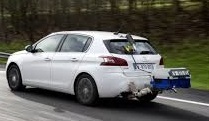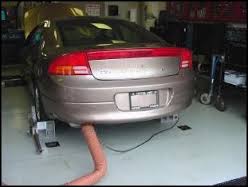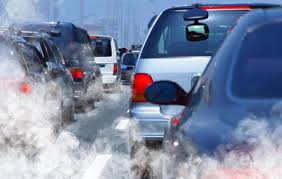We so often speak about breathtaking performance or the way the sudden, even violent acceleration of an ultra-high performance car can literally cause moments of breathlessness. Equally, anyone who’s ever driven an expensive, high-performance car through an Irish city or village will be familiar with the strange feeling of guilt that comes over you – guilt at having spent so much money on a car (assuming you have of course – fast cars can be picked up for peanuts second hand) and guilt too at apparently singlehandedly wrecking the environment around you.
But hold on a minute. Maybe that guy or girl who’s just rewarded themselves for years of hard work with a new Maserati or even just a rapid hot hatch isn’t doing so much to wreck the Earth. The latest round of EQUA air quality index reports is out and it makes for some slightly odd reading if you’ve ever, reasonably, assumed that high performance of the Supercar equals high emissions. The EQUA reports are carried out by Emissions Analytics, an independent group which has begun analysing the real-world emissions of vehicles using the proposed on-road testing standards which the EU is supposedly going to introduce in 2017.
Unexpected results
 And those expecting the best-performing cars to be some kind of saintly hybrid or a diesel with a clever exhaust treatment system might be surprised. Actually, the Porsche Boxster came top of the latest set.
And those expecting the best-performing cars to be some kind of saintly hybrid or a diesel with a clever exhaust treatment system might be surprised. Actually, the Porsche Boxster came top of the latest set.
The Boxster, or 718 Boxster as we’re now supposed to call it, has recently had a significant engine change, dropping its old 2.9 and 3.4-litre, naturally aspirated flat-six engines in favour of 2.0 and 2.5-litre flat-four turbos, to the detriment of aural quality but much to be benefit of emissions and fuel consumption. And, it would now seem, air quality.
Emissions & harmful gases
 The EQUA tests are focused much more on emissions of Nitrogen Oxides (NoX), the harmful gases, caused by burning combustible fuels, which can cause utter havoc with your lungs, leading to asthma, respiratory illness and even heart attack and death. It’s these emissions which have been on everyone’s mind and everyone’s breath since the Volkswagen ‘dieselgate’ scandal broke last September – VW’s ‘defeat device’ was designed to disguise NoX emissions.
The EQUA tests are focused much more on emissions of Nitrogen Oxides (NoX), the harmful gases, caused by burning combustible fuels, which can cause utter havoc with your lungs, leading to asthma, respiratory illness and even heart attack and death. It’s these emissions which have been on everyone’s mind and everyone’s breath since the Volkswagen ‘dieselgate’ scandal broke last September – VW’s ‘defeat device’ was designed to disguise NoX emissions.
In the EQUA tests, cars which are rated in Band A for NoX emissions are the cleanest – they not only meet current regulations but will continue to do so for some time yet, and the Boxster 718, with its new engine, slots neatly into Band A.
Fair enough, you might think – the Boxster might be fast and fun, but it’s also small and relatively light. Why wouldn’t it be in Band A for NoX emissions? Ah, but it’s joined there by some other big hitters in the performance car league. The new 911 Carrera S Coupe, which keeps six cylinders but which has also been downsized (to 3.0-litres) and given a brace of turbos, also snags a Band A rating as does the rather rapid Audi TT 1.8 TFSI Sport.
Car models and results
But wait, there’s better. The next time you hear a snarl, a whoosh of wastegate noise and the unmistakeable sound of tyres being tortured, instead of thinking ‘oh bloody hell, here comes a boy racer’ you can instead think ‘ah, here comes a nice young chap with his Ford Focus RS, helping to keep my lungs clear.’ Yes, the 2.3-litre turbo 350hp Ford Focus RS, with its lurid and lairy ‘Drift Mode’ button, is in Band A.
For those seeking a more sensible family motor, the new Ford Kuga 1.5 EcoBoost is also in Band A according to EQUA’s latests results. You may be noticing a pattern here – all of the cars, and especially the high performance ones, are burning petrol. And it’s true, petrol cars tend to emit much less NoX than diesel cars, the reverse of the position when taking climate-changing carbon dioxide (Co2) into account. So is it a case of save the planet but burn your lungs? Not necessarily – some diesels did well in the latest tests too, and once again the tarnished Volkswagen Group is leading the way. The VW Passat CC 2.0 TDI and Skoda Superb 1.6 TDI were joined by the BMW 320d EfficientDynamics in getting a Band C rating from EQUA – not as good as a Band A rating of course, but it does mean that they at least meet all current legislative requirements on NoX.
Fuel type and emissions
 The struggle between diesel’s low carbon emissions and petrol’s low NoX emissions is set to continue for some time yet, at least until electric cars gain a stronger foothold. As a former head of Toyota in Ireland once told me, when discussing future plans for hybrid and electric cars “if we switch to diesel to contain climate change then we might save the planet but we’ll all be dead from lung disease and won’t be able to enjoy it.”
The struggle between diesel’s low carbon emissions and petrol’s low NoX emissions is set to continue for some time yet, at least until electric cars gain a stronger foothold. As a former head of Toyota in Ireland once told me, when discussing future plans for hybrid and electric cars “if we switch to diesel to contain climate change then we might save the planet but we’ll all be dead from lung disease and won’t be able to enjoy it.”
The trouble is that it might be both. A new study from the University of Edinburgh has found that, potentially, electric cars can be just as bad for local emissions of unpleasant pollutants as their petrol and diesel counterparts. Oddly, this has nothing to do with emissions from power stations generating the electricity for their batteries, and everything to do with tyres, brakes and dust.
According to researchers Victor Timmers and A.J. Achten, the problem is that while electric cars eliminate the emissions of pollutants from an exhaust pipe, the unpalatable fact is that the exhaust actually only accounts for around ten per cent of the car’s emissions of harmful, carcinogenic Particulate Matter (PM) emissions. The rest comes from brake dust, worn-away particles of tyre rubber and even just the stirring up of dust and dirt from the road. Worse, Timmers and Achten say that the weight of an electric car, which is usually greater than that of a conventional diesel or petrol car, has a direct and worsening effect on these emissions. Their report said that “this review found that there is a positive relationship between weight and non-exhaust PM emission factors. In addition, electric vehicles (EVs) were found to be 24 per cent heavier than equivalent internal combustion engine vehicles (ICEVs). As a result, total PM emissions from EVs were found to be equal to those of modern ICEVs. Therefore, it could be concluded that the increased popularity of electric vehicles will likely not have a great effect on PM levels. Future policy should consequently focus on setting standards for non-exhaust emissions and encouraging weight reduction of all vehicles to significantly reduce PM emissions from traffic.”
Other impacting factors
 It should be obvious, really. Weight has always been the enemy of efficiency. Just ask a Formula One designer. The late, great Colin Chapman of Lotus was justly famed for reducing the weight of his cars to make them ever quicker than the opposition. A possibly-apocryphal story is told of Chapman at practice for the Indianapolis 500, berating Lotus mechanics for putting tiny steel washers onto a bolt before screwing it tight. “Take those washers off,” he reportedly said. “I don’t want those washers going for a ride.”
It should be obvious, really. Weight has always been the enemy of efficiency. Just ask a Formula One designer. The late, great Colin Chapman of Lotus was justly famed for reducing the weight of his cars to make them ever quicker than the opposition. A possibly-apocryphal story is told of Chapman at practice for the Indianapolis 500, berating Lotus mechanics for putting tiny steel washers onto a bolt before screwing it tight. “Take those washers off,” he reportedly said. “I don’t want those washers going for a ride.”
Performance car engineers are similar in their outlook. Every extra gram is anathema to making the car go faster, so the more stripped out a car is, the faster it goes. But it’s not just speed – it’s efficiency. If you drive a lightweight, high-performance car at normal speeds, and drive it with a little mechanical sympathy, you’d be surprised at how economical they can be.
This is not to suggest that we all run out and buy a Ferrari to save the planet (although, notably, it’s never been tried…) but merely to point out that the most efficient cars are not always the obvious ones.